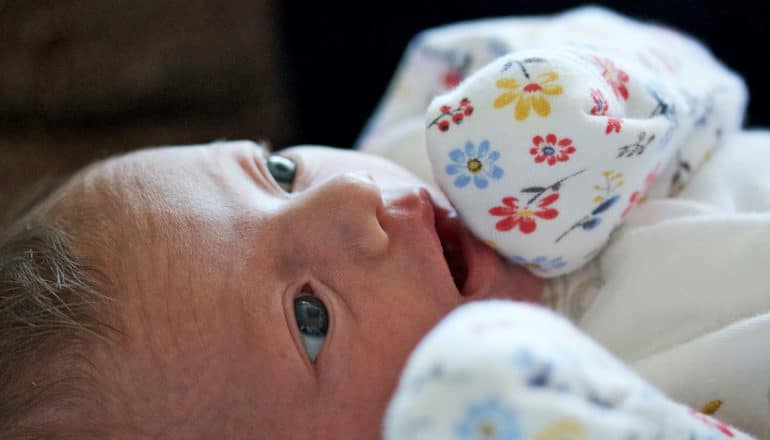
A biomarker in newborns may signal autism spectrum disorder months or even years symptoms or diagnosis, according to a new study.
Researchers found that infants diagnosed with autism later in childhood had very low levels of a neuropeptide associated with the disorder in their cerebrospinal fluid.
Experts say the earlier a child is diagnosed with autism spectrum disorder, the sooner interventions can start to help curb the negative effects of the disorder, such as social and communication challenges.
However, it’s not easy to identify autism before symptoms appear because blood or genetic tests that can flag the condition don’t exist.
“Autism currently is diagnosed behaviorally, mainly in children ages two to four years old, but these new findings suggest we might be able to better predict which newborns will go on to develop the disorder as children,” says John N. Constantino, professor of psychiatry and pediatrics at Washington University in St. Louis and co-senior investigator of the paper in the Proceedings of the National Academy of Sciences.
“This neuropeptide biomarker long predates clinical symptoms, and if confirmed, it could allow us to begin interventions much earlier in children who will go on to develop problems, further opening the possibility of pharmaceutical strategies to increase neuropeptide levels and, potentially, to prevent some problems associated with autism.”
Autism biomarker and risk
For the study, researchers examined cerebrospinal fluid samples collected during from a large cohort of feverish newborns cared for at St. Louis Children’s Hospital two decades ago. The scientists determined that babies whose samples had very low levels of the neuropeptide had a significantly higher likelihood to receive an autism diagnosis later in childhood.
Neuropeptides are short chains of amino acids. Researchers already suspect lower levels of the neuropeptide identified in the study—arginine vasopressin—in children with autism.
Constantino, director of the Division of Child and Adolescent Psychiatry, says that research has linked variations in arginine vasopressin and oxytocin, another hormone, with autism spectrum disorder, but the new study offers the first evidence that levels of one of the hormones are abnormal so early in life.
Measuring the neuropeptide may provide an indicator of which children have the highest risk of developing autism, he says.
The study involved 913 newborns with fevers whose cerebrospinal fluid researchers examined and found no markers of meningitis. Researchers saved and stored the leftover spinal fluid.
Included in those samples was cerebrospinal fluid from nine children who went on to receive an autism diagnosis. The researchers compared those nine samples to samples from 17 age- and gender-matched children who did not receive an autism diagnosis.
The nine children diagnosed later in childhood had significantly lower levels of arginine vasopressin as infants than the 17 who did not go on to receive a diagnosis for the disorder.
“This new biological clue from a rare and unprecedented collection of newborn human spinal fluid samples needs to be pursued in larger numbers of children,” says co-senior investigator Karen J. Parker, associate professor and associate chair of psychiatry and behavioral sciences at Stanford University.
“Given the alignment of these findings with studies in older children and in nonhuman primates, we want to understand why this neuropeptide might have such a marked, predictive association with the development of autism spectrum disorder because it appears to be extremely predictive of future risk.”
What about ‘female protective effect’?
Parker and Constantino plan a larger study to collect cerebrospinal fluid from newborns and measure levels of their neuropeptides to see whether they can replicate the findings from this smaller study.
Measuring these autism biomarkers, while tracking a baby’s eye movements, motor impairment, hyperactivity syndromes, and other risk factors, could give doctors a clearer picture of which children have the highest risk to go on to develop autism and allow interventions much earlier in life.
Meanwhile, in a separate study, Constantino also found that some have overestimated a feared indicator of autism risk to babies.
A number of family and genetic studies over the past decade have generated a theory that a “female protective effect” explains the pronounced 3:1 male-to-female sex ratio in autism. In other words, females may have relative protection from autism compared with males, even though both males and females have similar genetic susceptibility.
The theory has generated widespread concern that the unaffected sisters of individuals with autism may have a high likelihood of transmitting genetic risk for autism to their sons.
Together with researchers from the Karolinska Institute in Sweden, the Icahn School of Medicine at Mt. Sinai in New York, and the Chinese University in Hong Kong, Constantino analyzed data from a large, two-generation population registry in Sweden to provide the first-reported estimates of risk among the offspring of adults who are siblings of a person with autism.
The researchers found that the children of sisters of individuals with autism don’t have are not significantly more likely to be affected by the disorder than the children of brothers of individuals with autism. The risk for both is 2% to 3%, or about 10 times lower than previously feared feared for sisters.
The Swedish study, published in the journal Biological Psychiatry, involved nearly 850,000 children born from 2003 through 2012.
“The findings suggest that the autism sex ratio is more a function of males being more sensitive to genetic susceptibility factors for autism, rather than females being protected,” Constantino says.
“That has important implications for the design of studies that look for the factors that result in the disproportionate risk for autism and related developmental disorders in boys.”
The Eunice Kennedy Shriver National Institute of Child Health and Human Development, the National Institute of Mental Health of the National Institutes of Health, and the Stanford University Department of Psychiatry funded the work.
Source: Washington University in St. Louis
The post Can this biomarker flag autism in newborns? appeared first on Futurity.
from Futurity https://ift.tt/35hZuo9
No comments:
Post a Comment